Abstract
Large-scale Mesozoic granites are widespread in the offshore area of eastern Shandong Province, China. This study aims to refine the granite classification and explore the degree of granite differentiation and ore-bearing potential in the study area. We conducted field investigations in Dazhushan, Xiaozhushan, and Laoshan plutons. The analytical methods included petrography, whole-rock geochemistry, Sr–Nd–Pb–Li isotopes, zircon U–Pb dating, in situ Hf isotopes, and microanalysis (LA-ICP-MS) of plagioclase. The results reveal high-silica (SiO2 > 70%), highly differentiated (DI > 90) granites emplaced during the Early Cretaceous (113.12–121.78 Ma). Sr–Nd–Pb isotopes indicate magma derived from a crustal source (ISr = 0.7032–0.7242; εNd(t) = −12.45~−20.46). Critically, the spodumene-bearing Dazhushan granites exhibit high Li content with limited isotopic fractionation (δ7Li = 1.00–4.62‰; Li = 8.64–93 ppm), signaling high ore potential. In contrast, the Xiaozhushan granites are barren (δ7Li = 3.31–4.92‰; Li = 0.66–4.01 ppm). This study identified I-type (Laoshan) and I-S type (Dazhushan and Xiaozhushan) highly differentiated granites formed by plagioclase fractionation, with Dazhushan being the most promising for mineralization.
1. Introduction
Numerous studies confirmed that the North China Craton (NCC) experienced lithospheric delamination from the Late Jurassic to the Early Cretaceous, and magmatic activity reached its peak [1,2,3,4,5,6,7]. During the Late Mesozoic, the Jiaonan region in eastern Shandong experienced widespread magmatism, attributed to the subduction and retreat of the Pacific Plate, rollback of the Izanagi Plate [8,9,10], and regional lithospheric thinning, thermal uplift, extension, and slipping [11,12,13]. The magmatic rocks almost belong to high-silica acidic intrusions. Zircon saturation temperature studies indicate that the Jiaonan granites formed under high-temperature conditions in the tectonic setting of lithospheric extension and thinning [14]. The geochronological framework of the Jiaodong area divides the Early Cretaceous into the Guojialing (123–135 Ma), Weideshan (110–123 Ma), and Laoshan (108–118 Ma) periods [15,16,17]; their geochemical characteristics are well documented [15,16,18,19,20]. Additionally, previous studies on the Xiaozhushan granites elucidated geochemical and petrogenetic features [21,22,23]. The Late Yanshanian I-type granites in eastern Shandong contain mafic enclaves, indicating magma mingling. Research on highly fractionated granites focused on mineralization potential, magma differentiation processes, and melt–fluid interactions [24,25,26]. Fractional crystallization controls the internal structure of granites, reflecting cooling crystallization processes [27]. Studies on highly differentiated granites in China also linked them to rare metal resources, establishing mineral characteristics for melt–fluid evolution in highly differentiated pegmatites [28].
Therefore, the differentiation degree and ore-bearing potential of granites in study area remain unexplored. To enhance the geochemical understanding of these granites, field investigations were conducted in Xiaozhushan, Dazhushan, and Laoshan. This study employed whole-rock geochemistry, Sr–Nd–Pb–Li isotopes, zircon U–Pb–Hf analysis, and micro-area techniques to investigate the highly differentiated granites of eastern Shandong offshore area and determine their emplacement age, magmatic evolution, and tectonic setting. By integrating the REE tetrad effect and Li isotopes and assessing the ore-forming potential of the Dazhushan granite, key insights into its differentiation processes and genesis are provided.
2. Geological Background and Sample Collection
During the Late Jurassic to the Early Cretaceous, eastern Shandong experienced intense tectonic-magmatic activity related to the paleo-Pacific Plate, forming volcanic-sedimentary basins. Within this tectonic setting, Jiaonan granites formed under a lithospheric extensional-thinning environment, driven by delamination in the lower lithosphere [1,3,14]. The study area has been in a state of uplift and denudation since the Late Cretaceous, eventually revealing modern Dazhushan and Xiaozhushan rock [29,30]. Dazhushan, located on the southwest coast of Qingdao City near Laizhou Bay, consists of Late Yanshanian Mesozoic acid-intrusive composite granites (Figure 1a) and the lithology includes medium- to coarse-grained K-feldspar granite and granite porphyry, distributed in a NW direction, with an exposed area of ~65 km2 [29,31].

Figure 1.
(a) geological map of eastern Shandong province; (b) geological map of Dazhushan granite; (c) geological map of Xiaozhushan granite; and (d) geological map of Laoshan granite.
Xiaozhushan, situated in the northern Jiaonan uplift of the eastern Sulu-Dabie orogenic belt, lies southwest of Jiaozhou Bay, adjacent to the Wulian-Qingdao fault and Jiaolai Basin, which is distributed in NE direction and represents the Late Yanshanian Laoshan period, dominated by monzogranite and syenogranite, with an exposed area of ~100 km2 [21,22,23]. Sampling locations are shown in Figure 1b. Ten Dazhushan samples were obtained from five sites: Shimensi (N 35°49′19″, E 119°57′15″); the mountaintop (N 35°47′58″, E 119°58′18″); Xiaozhaishan (N 35°47′22″, E 119°58′8″); Dazhaishan (N 35°47′12″, E 119°58′7″); and Dujuangu (N 35°47′15″, E 120°8′8″). Xiaozhushan samples collected from Lingzhushan National Forest Park (Figure 1c), covered all granite types. The sampling route included Dujuangu (N 35°58′50″, E 120°4′2″), Xiguding (N 35°58′25″, E 120°4′26″), Dongguding (N 35°58′25″, E 120°3′45″), and Futaitong (N 35°58′42″, E 120°4′14″). Quartz-vein-bearing granites were identified near the Xiaozhushan mountaintop well, where 10 samples were collected. Additionally, five samples were obtained from Laoshan to cover the exposed granites in eastern Shandong offshore area (Figure 1d), including Jiangjungu (N 36°15′14″, E 120°37′14″), Tuanguding (N 36°9′17″, E 120°37′17″), and the mountaintop (N 36°9′14″, E 120°40′6″).
3. Petrography
The Dazhushan outcrops comprise Mesozoic Laoshan period granites, including fine-grained alaskite (DZS-1), biotite granite (DZS-2), medium-grained alaskite (DZS-H), medium-grained granite (DZS-SS), granite porphyry (DZS-CD), and medium-grained syenogranite (GZK-1). These rocks exhibit a massive structure and granitic texture, with essential minerals being K-feldspar, plagioclase, and quartz. Plagioclase shows partial alteration to sericite and zoisite (Figure 2a,b). Cordierite was identified by Raman spectroscopy (Figure 2c). Emerald green spodumene occurs in pegmatitic dykes (DZS-H) (Figure 2d,e). Xiaozhushan is dominated by medium-fine-grained granite (XZS-F), porphyritic syenogranite (TL-2), granite porphyry (XZS-B), and pegmatite veins (XZS-PP) consisting of striped feldspar (40%), plagioclase (5%), quartz (20%), and biotite, classified as medium-grained biotite granite with fine-grained quartz veins. Medium-fine-grained granite porphyry is widely distributed (Figure 2f). Flake biotite is sporadically distributed, with some amphiboles replaced by microcrystalline biotite. Quartz is partially embedded in feldspar (Figure 2g). The mineral surfaces show slight corrosion and sericite–quartz alteration, particularly in K-feldspar (Figure 2h,i). Affected by surrounding minerals, the particles appear small and irregular. Veined samples show a medium-grained texture with localized sericitization (Figure 2l) and medium-grained granite structure with massive texture and localized sericitization (Figure 2f). Gray-black cordierite particles, associated with biotite cementation, were also observed (Figure 2f). In addition, laser Raman microscopy identified minerals with spectra, as shown in Figure 3. Dazhushan samples feature sericitized plagioclase phenocrysts with polysynthetic twinning. Medium-grained biotite granites adjacent to quartz veins show argillic alteration but maintain compositional similarity to the host rock. Xiaozhushan granite porphyry from Dujuangu contains a recrystallized felsic matrix with dispersed plagioclase, magnetite phenocrysts with dissolution textures, and biotite with darkened rims. Most samples exhibit devitrified quartz phenocrysts. The Futaitong samples are weakly altered medium-fine-grained biotite granites. The Laoshan samples display simpler mineralogy (Figure 2k), with quartz, K-feldspar and biotite that is visible in hand specimens (Figure 2l,m).
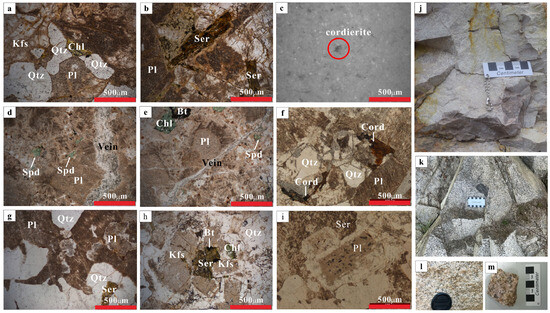
Figure 2.
Petrography of Dazhushan Xiaozhushan and Laoshan granites: (a) quartz and K-feldspar; (b) sericite and plagioclase; (c) cordierite point in Raman spectrometer; (d) spodumene particles around the vein; (e) vein interspersed with plagioclase; (f) plagioclase polysynthetic twin; (g) bay-shaped plagioclase; (h) plagioclase biotite cementation; (i) plagioclase sericitization; (j) granite field profile; (k) granodiorite; (l) alaskite; (m) granitic porphyry. (Spd: spodumene; Bt: biotite; Kfs: K-feldspar; Ser: sericite; Qtz: quartz; Pl: plagioclase; Chl: chlorite; Cord: cordierite).

Figure 3.
Cordierite verification results from XRD and laser Raman.
4. Analytical Methods
4.1. Petrography and Whole-Rock Major-Trace Elements
The petrographic analysis was conducted at the Open Laboratory for Lithospheric Dynamics and Geochemistry, China University of Petroleum (East China). Minerals were observed under a Leica optical microscope, the LEICA-DM2700P (Leica Microsystems, Wetzlar, Germany). After circling the dots, the in situ analysis of the EMPA micro-area was conducted. The minerals were examined under an optical microscope to identify plagioclase. X-ray diffraction (XRD) mineral analysis was completed at the State Key Laboratory of Heavy Oil Processing, China University of Petroleum (East China), using the XRD analyzer model XL3t950 (Thermo Fisher Scientific, Waltham, MA, USA). Laser Raman spectroscopy was performed at the Open Laboratory of Lithospheric Dynamics and Geochemistry of China University of Petroleum (East China). The Raman spectrometer used was the LabRam-010 (Jobin Yvon, Paris, France). The instrument uses a solid-state laser with a 532 nm light wavelength, 10 s counting time, grating 1800/mm, with 50 times the optical lens observation, and a 100–4000 cm−1 full-band peak. Under an optical microscope, the mineral bulge was noted; the laser Raman dot test was performed after the dots were obtained.
The samples were commissioned by F.Z.Y Rock and Mineral Analysis Detection Technical Services Ltd. (Heibei, China) and GeoAnalysis Co. Ltd. (Beijing, China). The major elements of the whole rock were analyzed using Panaco AxiosMAX X-ray fluorescence (PANalytical B.V., Almelo, The Netherlands). The precision and accuracy of the sample analysis met the requirements of the GB/T14506.28-2010 silicate rock chemical-analysis method, Part 28: Determination of 16 primary and secondary components [32]. Whole-rock trace element analysis was performed using Elan dynamic reaction cell enzyme-induced carbonate precipitation mass spectrometry (MS). The precision and accuracy of the sample analysis met the GB/T14506-2010 silicate rock chemical-analysis method, Part 30: Determination of 44 elements [33].
4.2. Zircon U–Pb and Lu–Hf Isotopes Analysis
F.Z.Y Rock and Mineral Analysis Detection Technical Services Ltd. and Beijing GeoAnalysis Co. Ltd. conducted the zircon U–Pb dating LA-ICP-MS. This work was performed using laser ablation (LA) inductively coupled plasma (ICP) MS. The LA platform adopted the resolution secondary electron (SE) 193 nm deep-ultraviolet LA sampling system (Applied Spectra, Sacramento, CA, USA), equipped with an S155 double-volume sample cell (Mass Spectrometer Agilent 7900 ICP Mass Spectrometer, Santa Clara, CA, USA). Detailed tuning parameters can be seen in [34]. Zr was mounted in epoxy disks, polished to expose the grains, and was cleaned ultrasonically in ultrapure water, then cleaned again before the analysis using a methanol analytical reagent. The exponential function calibrated the downhole fractionation [35]. Zr 91500 was used as the calibration standard sample; GJ-1 was used as the monitoring standard sample. Two 91500 standard samples and one GJ-1 standard sample were analyzed every 10–12 sample points.
The international standard sample 91500 was used as the external reference sample to determine of zircon Hf isotopes. The constant decay constant λ of 176Lu = 1.865 × 10−11/year, and the εHf (t) was calculated according to the 176Lu/177Hf ratio (0.0332) and 176Hf/177Hf ratios (0.282772) of the chondrite calculated by Blichert-Toft and Albarede [36]. The Hf model ages were calculated using the currently depleted mantle 176Lu/177Hf ratio (0.015) [37] and 176Hf/177Hf ratios (0.28325) [38]. The mass fractionation of the instrument was corrected by 179Hf/177Hf = 0.7325 [38]; the Hf isotope standard material Alfa Hf was used as an external standard to correct the instrument’s drift.
4.3. Whole-Rock Main-Trace Elements
F.Z.Y Rock and Mineral Analysis Detection Technical Services Ltd. and the Institute of Geology and Geophysics, China Academy of Science conducted the Sr–Nd–Pb–Li isotope tests. The whole-rock Sr–Nd–Pb isotope testing process was conducted using the following steps: (1) Pb was separated from other elements using a Biorad AG1-X8 anion exchange column (Hercules, CA, USA). Lithophile elements (Hf, Sr, and REEs) were initially washed from the column with a 0.2 mol/L HBr and 0.5 mol/L HNO3 mixture. After that, Pb was eluted with Mill-Q water. Due to the impure Pb fraction, a second anion exchange column was needed for further purification; (2) A Biorad AG50W-X8 cation exchange column was used to roughly separate the Hf, Sr, and REEs roughly; (3) The impure Sr fraction from Step (2) was dried, redissolved in 2.5 mol/L HNO3, and loaded into Sr-specific resin. Finally, Sr was extracted from the column with Mill-Q water. The Sr-specific resin was discarded after each chemical separation; (4) After the Sr–Nd–Pb component was evaporated, it was first dissolved in 1.0 mL 2% dilute nitric acid and used as a mother liquor, 100 mL was diluted to 1.0 mL, and the element content was accurately determined with an Agilent 7700x quadrupole ICP-MS (Agilent Technologies, Santa Clara, CA, USA). Using the 86Sr/88Sr = 0.1194 internal calibration instrument mass fractionation, the Sr isotope international standard substance NIST SRM 987 was used as an external standard calibration instrument drift, and the mass fractionation of the instrument was corrected by 146Nd/144Nd = 0.7219. The Nd isotope international standard material JNdi-1 was used as the external standard to correct instrument drift. The instrument mass fractionation was corrected by 205Tl/203Tl = 2.3885. The Pb isotope international standard substance NIST SRM 981 was used as the external standard to correct the instrument drift. Professor Su Li of the School of Geological Science and Mineral Resources of Lanzhou University at the University of Maryland partly completed the Li isotope. Beijing GeoAnalysis Co. Ltd. commissioned the rest of the Li isotope. A multicollector (MC) ICP mass spectrometer (Thermo Fisher Scientific, Waltham, MA, USA) was used to separate and purify the liquid phase containing the Li ions. The sample and standard substance (L-SVEC) were subjected to a sample–standard sample cross-method to correct Li isotope mass discrimination. The Li isotope test results, with a relative deviation of δ7Li, is expressed as follows:
δ7Li = {[(7Li/6Li)sample/(7Li/6Li)L-SVEC]−1} × 1000.
4.4. Plagioclase EMPA and LA-ICP-MS
The plagioclase EMPA test was completed at the Key Laboratory of Deep Oil and Gas of the China University of Petroleum (East China) using the EPMA-1720 (Shimadzu, Tokyo, Japan). SE image experiments, backscattered electron (BSE) image observation, element quantitative analysis, and energy spectrum analysis of major element oxides were conducted. The acceleration voltage was 15 kV, the probe current was 30 nA, and the electron beam diameter was 20 μm. A larger electron beam was used because the mineral particles were large. The standard samples were sodium aluminosilicate and potassium titanyl phosphate; the test item was oxide. The selected elements were Na, Mg, Al, Si, P, K, Ca, and Fe, and the element characteristic peak setting time was 10 s. Two points were selected for each test point to average the results. The energy spectrum analysis set the scanning time to 25 sheet/s and ensured that the magnification of the BSE image observed by the EMPA was consistent. One to two points on each BSE image were selected for element content analysis and the time was to 40 piece/s to ensure accuracy. The energy-spectrum scanning analysis primarily evaluated Na, Mg, Al, P, K, and Ca, with scan times controlled to between 8 to 10 times.
The in situ LA-ICP-MS laser-spotting test of the plagioclase micro-area was completed at the Institute of Geology and Geophysics, Chinese Academy of Sciences, using the Plasma Quant MS Elite ICP-MS (Analytik Jena, Jena, Germany) and its matching resolution SE 193 nm excimer laser-denudation system. The laser denudation was performed with a beam diameter of 50 μm, a frequency of 6 Hz, and an energy density of approximately 6 J/cm2. The carrier gas was high-purity helium. Before testing, the NIST 610 was used for debugging the instrument to obtain optimal conditions. LA-ICP-MS laser denudation sampling was conducted by single-point denudation. In the test process, the laser beam was blocked for blank background acquisition for 20 s; the sample was denudated for 45 s continuously. After the denudation stopped, the sample was pursued for 20 s to clean the injection system; the single-point test analysis time was 85 s. A group of NIST 610, NIST 612, BHVO-2G, BCR-2G, and BIR-1G were inserted for every 10 denudation points, and the element content was quantitatively calculated with Si as the internal standard. The offline processing of analytical data (including sample and blank signal selection, instrument sensitivity drift correction, and element content calculation) was performed using ICP-MS Data Cal software (V. 4.6) [39,40].
5. Results
5.1. Whole-Rock Major and Trace Elements
The major and trace elements results of the granite samples in the study area have similar characteristics (Tables S1 and S2), with all samples classified as granite (Figure 4a). The major element compositions are as follows: SiO2 = 71.9%–78.4%; K2O + Na2O = 7.7%–9.8%; K2O/Na2O = 0.78–2.98; Mg# = 8.37–37.46; A/CNK = 0.96–1.21; and A/NK = 1.05–1.31. The results indicate metaluminous to peraluminous high-potassium calc-alkaline series (Figure 4b). All samples exhibit high differentiation degrees, with a differentiation index (DI) = 82.91–97.21 and a solidification index (SI) = 0.34–4.02. Zircon saturation temperatures were 836.26–851.76 °C for Dazhushan, 788.85–875.87 °C for Xiaozhushan, and 839.82–875.62 °C for Laoshan. The primitive mantle normalized trace element diagram (Figure 4c) shows that the samples are enriched in large ion lithophile elements and depleted in high field strength elements; Sr and Ti are strongly depleted; and Nb negative anomalies are obvious. The REE characteristics include: ΣREE = 52.1–253.9 × 10−6; LREE = 44.1–225.6 × 10−6; HREE = 13.6–53.9 × 10−6; LREE/HREE = 2.4–18.3; and (La/Yb)n = 4.48–55.89. LREE enrichment and HREE depletion are evident, with δEu = 0.11–0.77, indicating strong negative Eu anomalies. The REE patterns show moderate LREE enrichment, flat HREE distribution, and seagull-type characteristics in the chondrite-normalized diagrams (Figure 4d).
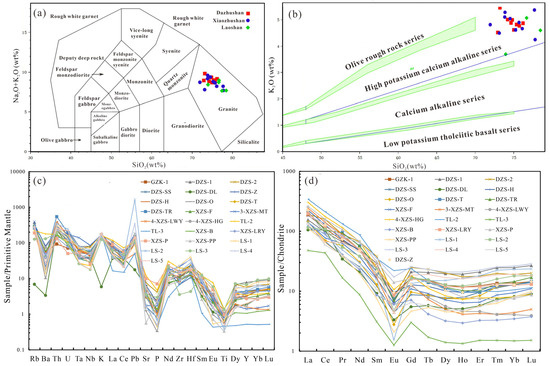
Figure 4.
(a) TAS diagram after [41]; (b) K2O-SiO2 diagram after [42]; (c) REE distribution pattern after [43]; (d) primitive mantle-normalized trace element spider diagram after [43].
5.2. Zircon Geochronology and Lu–Hf Isotopes
The geochronological studies in the research area focused on the diagenetic and metallogenic ages of Dazhushan, Xiaozhushan, and Laoshan. LA-ICP-MS U–Pb dating was performed on 30 zircons from the Dazhushan sample DZS-DL, yielding 22 valid data points with a concordance > 85%. The zircons exhibited elongated euhedral shapes (100–130 μm, aspect ratios 3:1–2:1) and magmatic oscillatory zoning in the cathodoluminescence CL images, although some showed high-U or recrystallization features [44] (Figure 5d,g). Zircon U and Th contents ranged from 156–941 × 10−6 and 195–1403 × 10−6, respectively, with Th/U = 0.98–2.75 (Table S3), consistent with magmatic zircon (Th/U > 0.4). The ZrO2 content was 61.60%–68.69%, with low trace elements, HREE enrichment, a positive Ce anomaly (59.5–411.5), and a negative Eu anomaly (0.13–0.36) (Figure 5f) (Tables S4 and S5). The weighted average age of 22 concordant data points was 117.2 ± 2.1 Ma (MSWD = 1.45) (Figure 5d,e). Furthermore, 35 zircons from the spodumene-bearing sample DZS-H were analyzed, yielding 33 concordant data points (>95% concordance; Table S3). The euhedral crystals (100–180 μm, aspect ratio ~2:1) display magmatic oscillatory zoning in CL images, with dense banding suggesting slow crystallization in high-viscosity magma (Figure 5f,i) [45]. The U and Th concentrations ranged from 248 to 2145 × 10−6 and 210 to 2270 × 10−6, respectively, with Th/U ratios of 0.76–2.08 (Tables S4 and S5), consistent with magmatic origins (Th/U > 0.4; Table S3). The weighted concordia age was 113.1 ± 0.4 Ma (MSWD = 0.73; Figure 6a,b). The REE patterns are consistent with DZS-DL (Figure 6c).
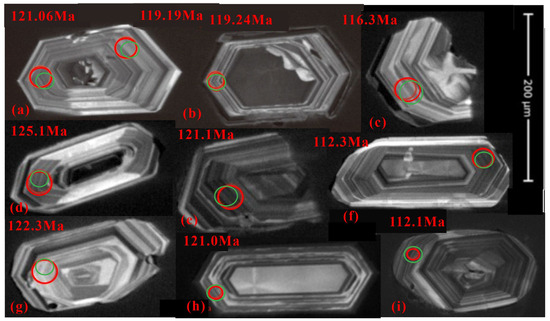
Figure 5.
The representative zircon cathode luminescence images of the research area. Samples (Red circle: U–Pb; Green circle: Lu–Hf): (a) LS; (b,c) LRY-HGY; (d) DZS-DL; (e) DZS-H; (f) DZS-H; (g) DZS-DL; (h) LS; and (i) DZS-H.
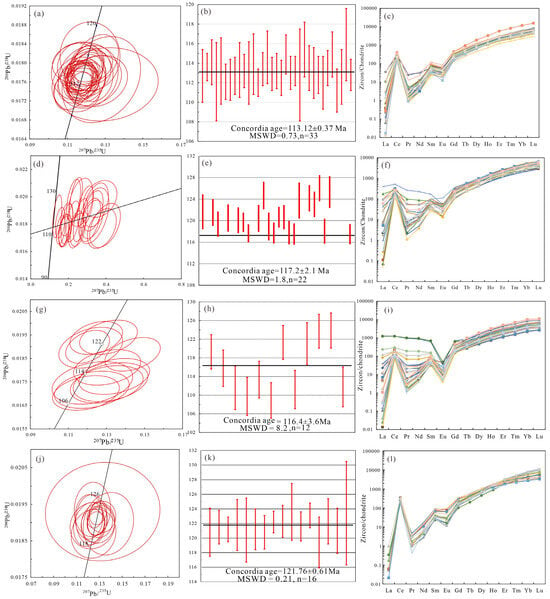
Figure 6.
The representative zircon-age concordia diagram of samples, weighted concordia age diagram and zircon rare earth elements distribution pattern diagram: (a–c) DZS-H; (d–f) DZS-DL; (g–i) LRY-HGY; and (j–l) LS.
Dating analysis of the 29 zircons from the Xiaozhushan samples yielded 12 concordant data points (>85). The euhedral short-prismatic crystals (120–150 μm, aspect ratio ~5:3) exhibited magmatic oscillatory zoning in CL images (Figure 5b,c), typical of magmatic zircons. U and Th contents ranged from 636 to 3515 × 10−6 and 531 to 2864 × 10−6, respectively, with Th/U ratios of 0.81–1.42 (Table S3), consistent with magmatic origins (Th/U > 0.4). ZrO2 content is high (62.63%–70.57%). Trace elements were low, showing HREE enrichment, pronounced Ce positive anomaly (2.5–174.5), and Eu negative anomaly (0.02–1.1) (Figure 6i) (Tables S4 and S5). The weighted concordia age was 116.4 ± 3.6 Ma (MSWD = 8.2; Figure 6g,h). For the Laoshan sample (LS), 16 concordant data points (>95%) were obtained. The crystals were predominantly short-prismatic to granular (80–150 μm, aspect ratio ~2:1) with subhedral morphology. The CL images show magmatic oscillatory zoning (Figure 5a,g,h), indicative of magmatic zircons. U and Th contents ranged from 148 to 1537 × 10−6 and 184 to 2750 × 10−6, respectively, with Th/U ratios of 1.17–2.9 (Table S3), consistent with magmatic origins (Th/U > 0.4). The weighted concordia age is 121.8 ± 0.6 Ma (MSWD = 0.54; Figure 6j,k) (Tables S4 and S5). The REE patterns are similar to those of the Xiaozhushan zircons (Figure 6l).
Zircon Hf isotopic analyses provide key constraints on magma sources [46]. In situ Hf isotope analysis was conducted on 12 high-concordance zircon spots from the Xiaozhushan samples (Table S6). The 176Hf/177Hf ratios ranged from 0.00159 to 0.00463, all below 0.002, indicating minimal radiogenic Hf accumulation post-crystallization. Thus, the measured 176Lu/177Hf ratios reflect the values observed during zircon formation. The initial 176Hf/177Hf ratios for the granite porphyry (116.4 ± 3.6 Ma) ranged from 0.2821 to 0.2822 (avg. 0.2821), with εHf(t) values of −15.071 to −20.288 (avg. −19.046; Figure 7). The first-stage (TDM1) and second-stage (TDM2) Hf model ages were 1.44–1.72 Ga and 2.12–2.46 Ga (avg. 2.38 Ga), respectively. For the Laoshan samples, 11 spots were analyzed (Table S6). The 176Hf/177Hf ratios ranged from 0.0017 to 0.0025, also indicating negligible radiogenic Hf accumulation. The initial 176Hf/177Hf ratios for the granites (121.78 ± 0.61 Ma) ranged from 0.28201 to 0.28208 (avg. 0.28205), with εHf(t) values of −21.625 to −24.333 (avg. −23.123; Figure 6), suggesting an ancient crustal magma source. The TDM1 and TDM2 model ages were 1.67–1.79 Ga and 2.53–2.69 Ga (avg. 2.61 Ga), respectively.
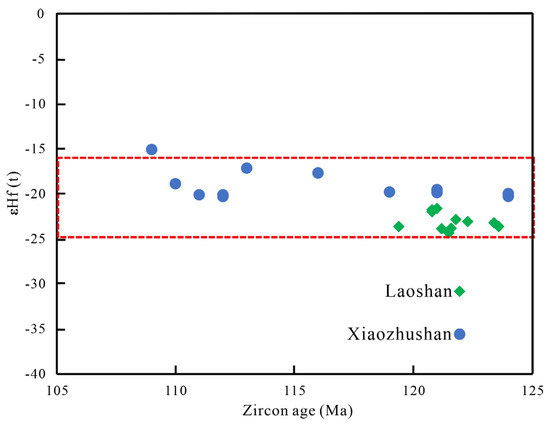
Figure 7.
εHf (t)-Ma scatter plot and histogram of Xiaozhushan and Laoshan samples.
5.3. Sr–Nd–Pb–Li Isotopes
Selected samples from the study area were analyzed for whole-rock isotopes. Dazhushan highly differentiated granite showed 87Sr/86Sr = 0.712–0.725, 143Nd/144Nd = 0.5116–0.5118, ISr = 0.703–0.724, εNd(t) = −16.28 to −19.97 (Figure 8a), fSm/Nd = −0.402 to −0.560, and Pb isotopic ratios of 206Pb/204Pb = 16.228–16.494, 207Pb/204Pb = 15.447–15.469, and 208Pb/204Pb = 36.735–37.043. Corrected initial Pb ratios were (206Pb/204Pb)i = 16.131–16.392, (207Pb/204Pb)i = 15.44–15.46, and (208Pb/204Pb)i = 36.48–36.72 (Figure 8b). Sr content negatively correlated with 87Sr/86Sr, while Rb content showed a positive correlation (Figure 8d). Xiaozhushan highly differentiated granite exhibited 87Sr/86Sr = 0.711–0.731, 143Nd/144Nd = 0.5116–0.5120, ISr = 0.7032–0.7242, εNd(t) = −12.45 to −18.71 (Figure 8a), and fSm/Nd = −0.595 to −0.656. Pb isotopes from vein-bearing granite and the most differentiated samples yielded (206Pb/204Pb)i = 16.69, (207Pb/204Pb)i = 15.46, and (208Pb/204Pb)i = 37.29. Laoshan granite sample LS-2, with the highest differentiation, yielded 87Sr/86Sr = 0.7161–0.7312, 143Nd/144Nd = 0.5116–0.5117, εNd(t) = −18.562 to −20.463 (Figure 8a), fSm/Nd = −0.3643 to −0.5678, and Pb ratios of 206Pb/204Pb = 16.314 and 207Pb/204Pb = 15.4. Laoshan exhibited more negative εNd(t), while Xiaozhushan exhibited higher εNd(t) and 87Sr/86Sr than Dazhushan and Laoshan (Figure 8a) (Table S7). Whole-rock Li isotope analyses of Dazhushan and 4 Xiaozhushan samples showed Dazhushan δ7Li = 1.00‰–5.66‰ (avg. 3.31‰) with Li = 8.64 × 10−6–93.00 × 10−6, and Xiaozhushan δ7Li = 3.24‰–6.66‰ (avg. 4.92‰) with Li = 0.66 × 10−6–4.01 × 10−6 (Figure 8c). Li content negatively correlated with δ7Li (Table S8, Figure 8c).
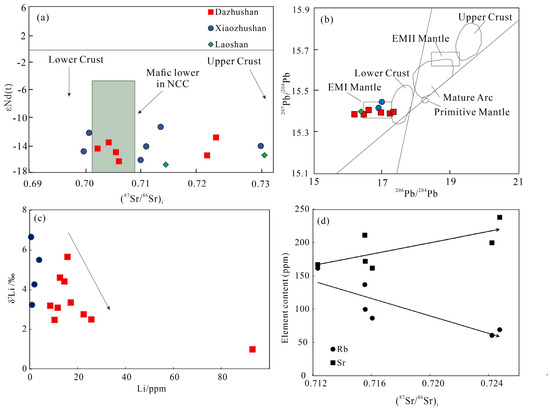
Figure 8.
Sr–Nd–Pb–Li isotope test results in the study area: (a) initial Sr–Nd isotopic composition of study area granites; (b) Ph isotopic compositions diagram of study area granites; (c) Li-δ7Li diagram of Zhushan granites; and (d) correlation diagram of Sr–Nd isotopes and elements of study area granite. [The late Paleozoic intrusions in the northern margin of the NCC are referenced from [47] and EMl, EMll, HlMU and Primitive Mantle after [48]; lower crust, mature arc and upper crust after [49]].
5.4. Plagioclase in Situ Analysis
The BSE images were magnified to 50× and 60× (Figure 9a,b) based on mineral characteristics [26]. The plagioclase oxide content in Table S9 has totals close to 100%, confirming accurate standard sample selection. EMPA and elemental mapping confirmed plagioclase locations through distinct Na-K distributions (Figure 9c,d), confirming plagioclase location and growth in granite. The Xiaozhushan granite samples used EMPA and energy spectrum surface-scanning. The SE and BSE images display plagioclase embedded between quartz in elongated forms with surface growth stripes (Figure 9e,f), indicating continuous plagioclase growth during fractional crystallization. The electron probe showed low oxide totals and characteristics, suggesting plagioclase verification. Consequently, energy spectrum surface-scan tests were conducted, revealing plagioclase positions (Figure 9g,h) and primary oxide variations during stripe growth (Table S10).
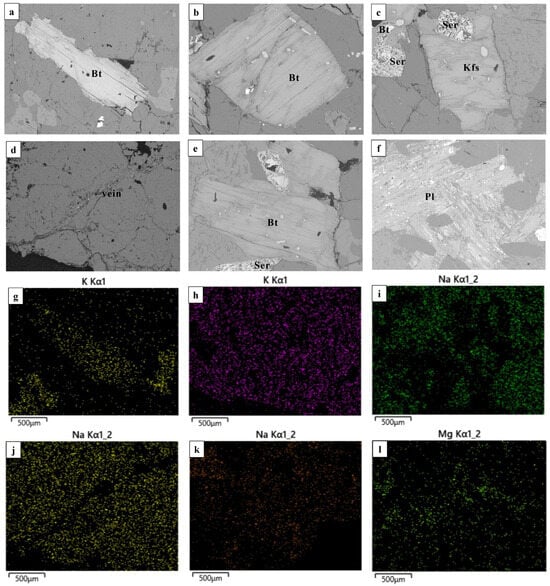
Figure 9.
Energy spectrum scanning results and backscattered electron images of study area feldspar minerals: (a,b) Dazhushan back-scatter diagram; (c,d) Dazhushan surface scan results; (e,f) back-scatter plot of Xiaozhu Mountain; (g,h) Xiaozhu mountain sweep results; (i,j) Laoshan back-scatter diagram; and (k,l) Laoshan surface scan results. (Bt: biotite; Kfs: K-feldspar; Pl: plagioclase; Ser: sericite).
Laoshan granite spectral analysis revealed feldspar bands with distinct rhythmic patterns, showing quartz-filled fractures overprinted by sericite–biotite–chlorite alteration (Figure 9i,j). Plagioclase growth zoning exhibited systematic trace element variations, confirming the fractional crystallization processes. Well-developed oscillatory zoning—including marginal, lateral, and intermediate inner core zones—demonstrated progressive compositional evolution during magma differentiation (Figure 10A(a–l)). The ring structure of the Dazhushan sample (Figure 10A(a–d)) was clearer than that of Xiaozhushan (Figure 10A(e–h)). Xiaozhushan was the most annuli-incomplete, with internal and external zones often divided into two distinct regions (Figure 10A(b,c)). In contrast, Dazhushan exhibited more complex zoning, with two zones further subdivided into three or dense bands divided into finer zones (Figure 10A(i,j)). Plagioclase zoning patterns indicate more complex mineral growth in Dazhushan than Xiaozhushan, highlighting its higher research significance. Major element data confirm that the analyzed minerals are plagioclase (Table S11), with laser ablation providing trace element compositions. Analysis reveals elevated Ba, Sr, Cr, Li, and Rb concentrations, while other elements show no systematic variations (Figure 10B). All feldspar plots are within the An–Ab–Or system, characterized by high Na2O (2.94–4.74 wt%) and Al2O3 (10.27–14.72 wt%) but low CaO (0.09–1.17 wt%), yielding An values of 10.32–19.69. These low-An compositions (albite–oligoclase) indicate crystallization in a low-temperature environment.
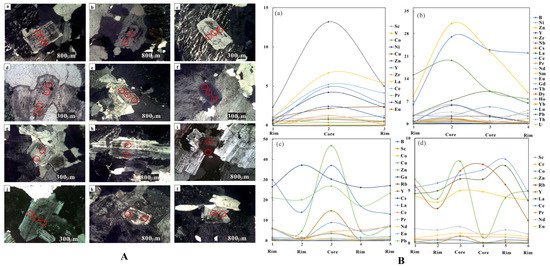
Figure 10.
Results of trace element analysis of plagioclase in the research area (A) the location image of feldspar mineral ring in the study area: (a–d) Dazhushan; (e–h) Xiaozhushan; and (i–l) Laoshan. (B) line chart of trace element variation in in situ micro area of study area plagioclase: (a) DZS-1; (b) XZS-1; (c) TL-3; and (d) LS-1.
6. Discussion
6.1. Sample Rock Types and Magma Source Area
Highly differentiated granite, also known as light-colored granite or alaskite, is formed from intense crystallization differentiation [50,51]. The geochemical analysis, characterized with the aluminum saturation index (A/CNK) was >1.1, exhibiting high SiO2, Al2O3, a peraluminous nature (A/CNK > 1.1), and high-K calc-alkaline affinity. These were enriched in lithophile elements but depleted in HFSE, with DI > 88 and zircon saturation temperatures ~750 °C [52]. The granite classification includes I-type (igneous source), S-type (sedimentary source) [52], and M-type (mantle-derived) [53,54]. The A/NK–A/CNK diagram shows that the three study area samples fall within the peraluminous granite field. The Dazhushan samples exhibited a higher proportion of peraluminous compositions compared to Xiaozhushan and Laoshan (Figure 11a).
Highly differentiated granites are identified by A/CNK > 1. Mineral assemblages in the Xiaozhushan samples, including cordierite and plagioclase, support S-type classification, which was further confirmed by their characteristic laser Raman spectra (Figure 2 and Figure 3). The 10,000× Ga-Zr diagram effectively discriminates A-type, I-type, and S-type granites. (Figure 11c) [55]. Samples from the study area exhibited high Ga/Zr ratios, plotting primarily within I-type and S-type granite fields. Combined with their shared geochemical features [56], they were interpreted as highly differentiated I-type and I-S-type granites. Pronounced negative Eu anomalies indicated extensive fractional crystallization. Low Yb (<2 × 10−6) and Sr (<100 × 10−6) contents reflected a medium-pressure diagenetic environment. (Table S2). Low Yb content implies garnet residues, while low Sr and negative Eu anomalies indicated plagioclase residues. A Be content > 4 × 10−6 further supports the classification as differentiated granite (Table S2). The Xiaozhushan samples averaged 4.5 × 10−6 Be, confirming this characteristic. Combined with DI = 92.56, these data indicate the presence of highly differentiated I-type and I-S-type granites in the Xiaozhushan region (Figure 11b,d).
The magma source identified using Sr–Nd–Pb isotopes, revealing crustal characteristics. Granite Mg# correlates with the mantle input, crustal-derived magma that is typically Mg# < 45, increasing with basalt intrusion [57]. The study area granite Mg# ranged from 8.37 to 37.46 (avg. 22.9), indicating a crustal source. Nb/Ta ratios (10.32–24.35, avg. 17.3) exceeded the crustal average (11.5) and approached the mantle average (17.7) [43], suggesting continental crust melting. Zircon εHf(t) values (−15.07 to −20.288) further confirmed the ancient crustal source. Combined isotopic and geochemical evidence indicated that the highly differentiated granite originated primarily from crust. The Pb isotopes point to a lower crustal source, with Xiaozhushan showing less of a mantle influence than Dazhushan and Laoshan. The homogeneous Lu–Hf signatures (Figure 7) support batch emplacement from a common crustal reservoir.
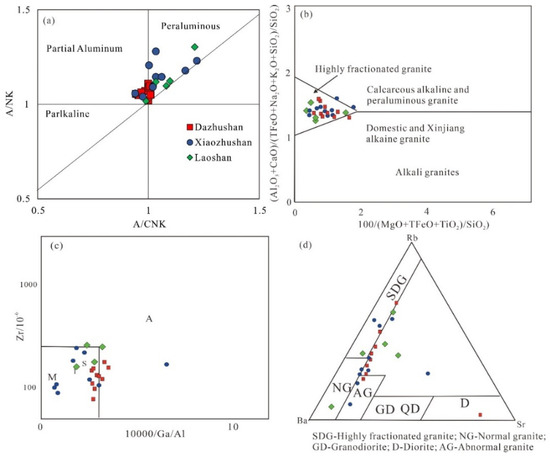
Figure 11.
Diagram of A/NK-A/CNK and granite types in the study area: (a) diagram of A/NK-A/CNK [58]; (b) diagram of alkaline granite–leucogranite; (c) granite type division diagram; and (d) granite differentiation degree diagram [59].
6.2. Time of Magma Intrusion and the Tectonic Setting
The chronology reveals that the Dazhushan highly differentiated granite (DZS-DL) dates to the Early Cretaceous. The spodumene-bearing Dazhushan sample (DZS-H) indicates an ore-forming age of 113.1 ± 0.4 Ma (MSWD = 0.73) during the late Yanshanian period. Following magmatic intrusion at 117.2 ± 2.1 Ma (MSWD = 1.45), crystallization differentiation formed ore-bearing pegmatite. The Xiaozhushan highly differentiated granite dates to 116.4 ± 3.6 Ma (MSWD = 8.2), and the Laoshan granite dates to 121.78 ± 0.61 Ma (MSWD = 0.54), with yield ages of 113–120 Ma, correlating with Late Yanshanian magmatism (Figure 12). This event comprises the Guojialing, Weideshan, and Laoshan suites, with the crustal-derived Laoshan I-A type granite reflecting a subduction-related setting [22,60,61]. The geochemical characteristics of surrounding granites have been studied extensively (Figure 12).
The study area is characterized by widespread Late Yanshanian intrusive rocks, mainly coarse-grained K-feldspar granite and granite porphyry. These granites formed in an extensional intraplate setting during the Early Cretaceous, where asthenospheric upwelling and lithospheric delamination triggered crustal melting [60,62]. Early Cretaceous lithospheric delamination triggered asthenospheric upwelling that heated and melted the crust, generating granitic magmas. These intrusions were later exhumed by Late Cretaceous uplift. Their high ISr and low εNd(t) values confirm a crustal origin through melting of the hydrated lower crust in an extensional setting.
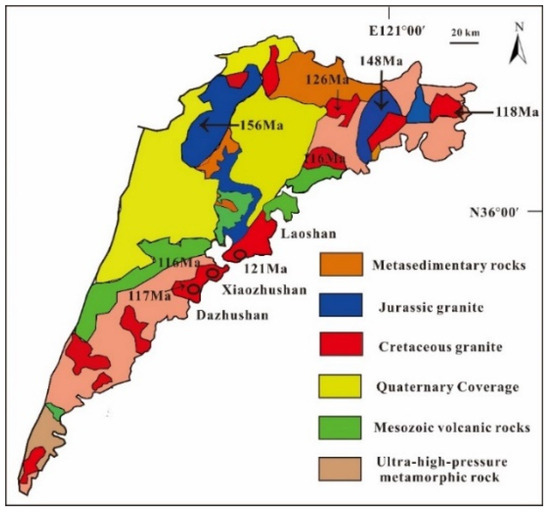
Figure 12.
Summary of geochemical characteristics for Mesozoic granites in the eastern Shandong (revised from [63]).
6.3. Evolution Process of Magma Differentiation
Magma differentiation generates varied compositions from a uniform magma via melt–residue and crystal–melt separation [64]. The evolution of the highly differentiated granite was inferred from zircon saturation temperatures Table S1, while the zircon Ti thermometry follows Ferry and Watson’s (2007) formula [65,66]. For the latter, αSiO2 and αTiO2 in this quartz-rich system were set to 1 and 0.6, respectively. The temperature calculation results are shown in Table S5. αSiO2 and αTiO2 represent the activities of SiO2 and TiO2. T is the temperature in Kelvin, lg (10−6Ti-in-Zircon) is the log value of Ti content in zircon.
lg(10−6Ti-in-Zircon) = (5.711 ± 0.072) − (4800 ± 86)/T(K) − lgαSiO2 + lgαTiO2
The zircon crystallization temperatures, reflecting magma crystallization temperatures, are as follows: Dazhushan granite ranges from 698.52 to 738.91 °C (avg. 712.15 °C); Xiaozhushan ranges from 681.84 to 726.44 °C; and Laoshan ranges from 698.52 to 711.92 °C. The negative correlation between Hf content and both temperature and Ti content indicates the extent of magmatic differentiation. These compositional variations trace the magma’s cooling and crystallization history. The higher zircon saturation temperature of the Dazhushan granite classifies it as a high-temperature granite. Its significantly lower magmatic crystallization temperature, derived from the zircon Ti thermometer, indicates substantial cooling from its origin to final diagenesis. This cooling process drove magmatic differentiation, ultimately forming a highly evolved granite. Such a rock—originating at high temperatures but consolidating at low temperatures—records a prolonged magmatic evolution dominated by crystal–melt differentiation, which was particularly efficient during the early stages due to lower melt viscosity.
During magma evolution, fractional crystallization of plagioclase and accessory minerals (e.g., apatite, zircon, monazite) occurred (Figure 13). The Hacker diagram reveals the relationship between SiO2 and oxide content (Figure 14). The significant decrease in CaO with increasing SiO2 (Figure 14b) indicates the separation of plagioclase and apatite [24]. The relative stability of K2O content might indicate magma mixing (potassium-rich end member and potassium-poor end member mixed in different proportions) or balanced partial melting (the melting behavior of potassium-bearing minerals remains stable when the source area is melted to varying degrees). Ba, Sr, and Eu decreased with rising SiO2, further indicating plagioclase separation and crystallization. Variations in Zr, Hf, and Th contents reflect fractional crystallization of accessory minerals during late-stage magma evolution. The decrease in Th, with increasing DI, points to monazite fractional crystallization, while declining Zr suggests zircon fractional crystallization [24]. The positive correlation between Sr content and 87Sr/86Sr values (Figure 8d) indicates that hydrothermal fluid metasomatism, adding Rb, caused the uneven Sr isotopic composition in the granite.
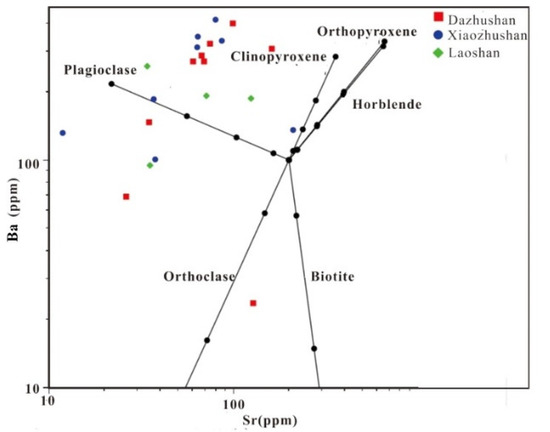
Figure 13.
The vector diagram of granite melt fractional crystallization mineral in the study area.
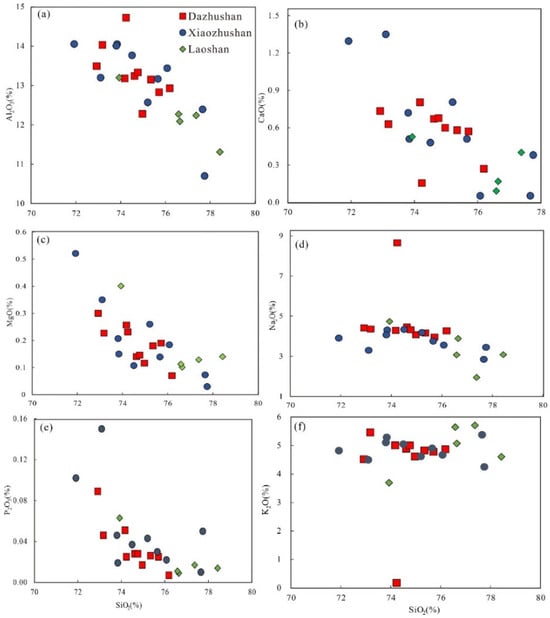
Figure 14.
Harker diagram of the high-differentiation granite in the study area. (a) Al2O3-SiO2; (b) CaO-SiO2; (c) MgO-SiO2; (d) Na2O-SiO2; (e) P2O5-SiO2; (f) K2O-SiO2.
The mineralogical evidence includes abundant chlorite and sericite, with vein and marginal textures. Zircon, exhibiting dark CL images and moderate Zr/Hf ratios, indicates a highly evolved magmatic environment. A continuous genetic link exists between the differentiated granite, pegmatites, and quartz veins, all derived from the same source via magma ascent [67]. Plagioclase, a key recorder of magmatic processes [68,69], was analyzed by LA-ICP-MS. Its compositional zoning and systematic trace-element variations from core to rim reflect magmatic evolution and oxygen fugacity changes. Given the association between pegmatites and rare metal deposits [70], plagioclase provides critical insights into these processes (Figure 10B). These variations exhibit a distinct pattern of lower concentrations at the rim and higher concentrations in the core, a characteristic particularly evident in high field strength elements (HFSEs). The stability of these elements under metamorphic conditions makes them reliable indicators of crystallization processes in acidic magmas. The analytical results confirm that growth proceeded from core to rim, with element partitioning controlled by evolving T-P conditions. The zoning documents both individual crystal growth and the evolution of the entire magmatic system.
6.4. Mineralization Potential Analysis
Two Mesozoic magmatic events in eastern NCC occurred at 130–120 Ma [71], with mineralization at 125–120 Ma. Highly differentiated granitic magma is important for the formation of granitic pegmatite-type rare metal deposits [26,68]. Mineralization is closely tied to magmatic differentiation and evolution [27]; metal enrichment during magmatic evolution forms ore bodies [8,28]. Felsic igneous is associated with gold, copper, tungsten, tin, molybdenum, bismuth, antimony, uranium, lithium, beryllium, niobium, tantalum, and cesium mineralization [72]. S-type granites typically host LCT deposits, while I-type granites are linked to Sn–Ti–B mineralization. Key indicators include high Sn in zircon, anomalies in δEu, δCe, δSn, and δCu [23], and low Nb/Ta ratios. S-type granites, modified by late magmatic fluids, provide favorable conditions. The tetrad effect of REEs, quantified by dividing chondrite-normalized patterns into four segments (La–Nd, Nd–Gd, Gd–Ho, Er–Lu) [60], serves to evaluate ore-forming potential in highly evolved magmas [73]:
TE1,3 = (T1 × T3)1/2, T1 = (Ce/CeT × Pr/PrT)1/2, T3 = (Tb/TbT × Dy/DyT)1/2,
Ce/CeT = CeN/(LaN2/3 × NdN1/3),Pr/PrT = PrN/(LaN1/3 × NdN2/3), Tb/TbT = TbN/(GdN2/3 × HoN1/3), Dy/DyT = DyN/(GdN1/3 × HoN2/3).
In the Dazhushan granite, samples with TE1,3 = 1.15 show a slight increase in ore-bearing potential with higher DI, consistent with petrographic spodumene observation. The Li2O content reached 0.66%, below the industrial grade of 1.50%, indicating sub-economic Li mineralization. A positive correlation between the REE tetrad effect and Li isotopes (Figure 15b) indicates that the tetrad effect enhances Li isotope enrichment [74], facilitating mineralization. The TE1,3-DI diagram shows that TE1,3 slightly increased with higher DI, reflecting the granite ore-bearing potential (Figure 15a). Zircon in ore-forming rocks exhibits high (Ce/Nd)/Y, δEu > 0.3, 10,000 × (δEu)/Y > 1, and whole-rock 10,000 × (δEu)/Y > 400, serving as indicators of ore-forming potential [74]. Studies have applied Li isotopes directly to granite source areas [75].
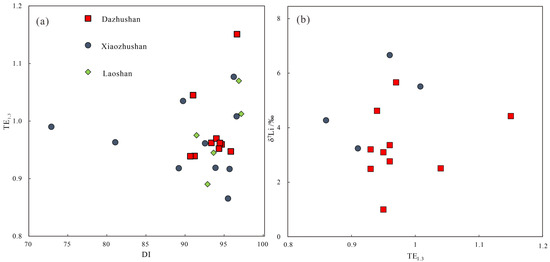
Figure 15.
(a) relationship between mineralization and DI of granite; and (b) relationship between mineralization and Lithium isotope of the study area granite.
Granitic differentiation promotes mineralization through element enrichment and fluid release. Lithium isotopes (δ7Li/δ6Li) are key tracers for fluid sources and migration, with higher values in pegmatite-type deposits indicating significant enrichment. Lithium enrichment (>100 ppm) is associated with highly differentiated magmatism (high DI) and alterations like greisenization and albitization. Structural features provide fluid pathways, concentrating mineralization in alteration zones. Lithium isotopes provide critical insights into the enrichment mechanisms of rare metals in granites during magmatic differentiation and hydrothermal processes [76]. The δ7Li values of partial melts derived from subducted oceanic crust typically range from 1‰ to 8‰ [77]. In this study, the δ7Li values of the analyzed samples were consistent with the mantle wedge in subduction zones (3‰–4‰) [77], suggesting early subduction processes with a negligible influence on the source region of the Early Cretaceous granites. The Dazhushan samples (TE1,3 > 0.95, max 1.15) exhibited stronger ore potential than Xiaozhushan (TE1,3 = 0.86–1.03, all <1.1; Table S12). The lower δ7Li in Dazhushan suggests more effective Li mobilization and extraction into fluids during late-stage fractionation, enhancing its metallogenic potential.
Yanshanian magmatism in eastern China is concentrated west of the southern Tanlu Fault Zone. The Liaodong–Jiaodong Peninsula hosts a Silicic Large Igneous Province (SLIP), characterized by alkaline rhyolite–granite suites exceeding 300,000 km2 and is associated with critical metal mineralization [78,79]. In eastern Shandong, Early Cretaceous (~120 Ma) magmatism exhibits bimodal alkaline rhyolite–basalt and high-K calc-alkaline assemblages, suggesting waning mantle plume activity and prolonged crustal magma residence [80]. Widespread high-silica granites and rhythmic rhyolitic tuffs in the Lingshan Island area confirm pulsating magmatic eruptions, supporting the presence of an offshore siliceous igneous province [81]. This study identifies the constraints for highly differentiated granites in offshore eastern Shandong Province: SiO2 > 73%, A/CNK > 1.1, DI > 88, magmatic origin temperature ~840 °C, and crystallization temperature ~710 °C. REEs tetrad effects (TE1,3 > 1.1) indicate ore-bearing potential, providing foundational data with which to clarify magmatism–mineralization relationships in the region.
7. Conclusions
(1) Highly differentiated granites (Dazhushan, Xiaozhushan, Laoshan) in eastern Shandong exhibit typical ore-bearing characteristics: SiO2 > 73%, A/CNK > 1.1, DI > 92, and TE1,3 > 1.1;
(2) I and I-S granites containing cordierite and spodumene occur in the study area, with differentiation dominated by plagioclase fractional crystallization. Zircon U–Pb dating yielded ages of 117.2 ± 2.1 Ma (MSWD = 1.45) for Dazhushan granite intrusion, 113.12 ± 0.36 Ma (MSWD = 0.73) for Dazhushan ore formation, 116.4 ± 3.6 Ma (MSWD = 8.2) for Xiaozhushan intrusion, and 121.78 ± 0.61 Ma (MSWD = 0.54) for Laoshan intrusion;
(3) Magmatic temperatures decreased from ~846 °C (saturation) to ~716 °C (crystallization), indicating significant cooling. Sr–Nd–P–Hf isotopes confirm crustal sources. Lithium fractionation and mineral assemblages demonstrate strong metallogenic potential;
(4) These I- and I-S-type granites were formed through mantle-derived heating-induced crustal melting, followed by prolonged fractional crystallization.
Supplementary Materials
The following supporting information can be downloaded at: https://www.mdpi.com/article/10.3390/min15111141/s1, Table S1. Major elements (%) in study area sample; Table S2. Trace elements and rare earth element (×10−6) in study area samples; Table S3. LA-ICP-MS Zircon U-Pb dating results of study area sample; Table S4. Trace Element Characteristics of study area Zircon (×10−6); Table S5. Calculation results of zircon trace element ratio and zircon Ti temperature of study area samples; Table S6. Zircon Hf isotope results of Xiaozhushan and Laoshan samples; Table S7. Sr-Nd-Pb Isotope Results of Samples in the Study Area; Table S8. Li isotope results of Zhushan sample; Table S9. Electron probe analysis results of plagioclase study area (%); Table S10. Spectroscopic scanning test result of study area sample; Table S11. In-situ trace element results of plagioclase micro-area in study area samples; Table S12. Analysis of mineral content of samples in study area.
Author Contributions
Conceptualization, R.L.; Methodology, R.L.; Software, R.L.; Validation, R.L.; Formal analysis, R.L.; Investigation, R.L.; Resources, R.L.; Data curation, R.L.; Writing—original draft, R.L.; Writing—review & editing, R.L. and T.C.; Visualization, R.L.; Supervision, Y.Z. and T.C.; Project administration, Y.Z., T.C. and H.Q.; Funding acquisition, Y.Z., T.C. and H.Q. All authors have read and agreed to the published version of the manuscript.
Funding
This study is supported by the SINOPEC Petroleum Exploration and Production Research Institute open fund (HX20220005) and the Project of Department of Science and Technology of SINOPEC (No. P20028). This study is supported by the SINOPEC Petroleum Exploration and Production Research Institute open fund (grant No. 33550007-21-ZC0613-0064), the Project of Department of Science and Technology of SINOPEC (grant No. P20028), the Maior Proiect of Shandong Energy Group Co. Ltd. (grant No. SNKJ2022A06-R23) and the Modeling and Thermal Extraction Development of Hot Dry Rock Reservoirs in Key Blocks of the Jiyang Depression (grant No. 30200018-24-ZC0613-0101).
Data Availability Statement
The data used in this study were obtained from the experiment and are referred to in the attached table.
Acknowledgments
Thanks to Beijing GeoAnalysis Co. Ltd. and F.Z.Y Rock and Mineral Analysis Detection Technical Services. Ltd. for their technical support. We are grateful to the reviewers for their constructive, careful reviews.
Conflicts of Interest
All authors were employed by the SINOPEC. The authors declare that they have no known competing financial interests or personal relationships that could have appeared to influence the work reported in this paper.
References
- Wu, F.Y.; Ge, W.C.; Sun, D.Y.; Guo, C.L. Discussions on the lithospheric thinning in Eastern China. Earth Sci. Front. 2003, 10, 51–60. [Google Scholar]
- Zhou, Y.Q.; Zhang, S.B. Disappearing mystery of ancient Pacific land and its relationship with Mesozoic-Cenozoic intraplate magmatism in North China Craton. Earth Sci. 2004, 29, 575–582. [Google Scholar]
- Gao, S.; Zhang, J.F.; Xu, W.L.; Liu, Y.S. Delamination and destruction of North China Craton. Chin. Sci. Bull. 2009, 54, 1962–1973. [Google Scholar] [CrossRef]
- Zhu, R.X.; Xu, Y.G. Western Pacific Plate Subduction and North China Craton Destruction. Chin. Sci. Bull. 2019, 49, 1346–1356. [Google Scholar]
- Zhang, Z.M.; Ding, H.X.; Dong, X.; Tian, Z.L. Partial melting of subduction zones. Acta Petrol. Sin. 2020, 36, 2589–2615. [Google Scholar]
- Yang, J.H.; Xu, L.; Sun, J.F.; Zeng, Q.; Zhao, Y.N.; Wang, H.; Zhu, Y.S. Geodynamics of decratonization and related magmatism and mineralization in the North China Craton. Sci. China Earth Sci. 2021, 51, 1401–1419. [Google Scholar] [CrossRef]
- Zhu, G.; Lu, Y.; Su, N.; Wu, X.; Yin, H.; Zhang, S.; Xie, C.; Niu, M. Crustal deformation and dynamics of Early Cretaceous in the North China Craton. Sci. China Earth Sci. 2021, 51, 1420–1443. [Google Scholar] [CrossRef]
- Zhang, Z.C.; Hou, T.; Cheng, Z.G. Mineralization related to Large Igneous Provinces. Acta Geol. Sin. 2022, 96, 131–154. [Google Scholar]
- Liu, J.L.; Ni, J.L.; Chen, X.Y.; Craddock, J.P.; Zheng, Y.Y.; Sun, Y.Q.; Ji, L. Parallel extension tectonics: Mechanism of Early Cretaceous thinning and destruction of the lithosphere of the North China Craton. Acta Petrol. Sin. 2020, 36, 2331–2343. [Google Scholar]
- Zhao, L.; Guo, F.; Zhang, X.-B.; Wang, G.Q. Cretaceous crustal melting records of tectonic transition from subduction to slab rollback of the Paleo-Pacific Plate in SE China. Lithos 2021, 384, 105985. [Google Scholar] [CrossRef]
- Sun, M.; Chen, H.; Milan, L.A.; Wilde, S.A.; Jourdan, F.; Xu, Y.Y. Continental arc and back—arc migration in Eastern NE China: New constraints on Cretaceous Paleo—Pacific subduction and rollback. Tectonics 2018, 37, 3893–3915. [Google Scholar] [CrossRef]
- Wang, S.; Wang, X.L.; Du, D.H. Studies on the Volcanic-Plutonic Connection. Geol. J. China Univ. 2020, 26, 497–505. [Google Scholar]
- Sun, W.D.; Xie, G.Z.; Zhang, L.P.; Liu, H.; Li, C.Y.; Sun, S.J. The onset of plate subduction and the evolution of continental crust. Acta Geol. Sin. 2021, 95, 32–41. [Google Scholar]
- Wang, T.; Liu, S. Zircon saturation temperatures of granites in the Jiaonan area and their geological significations. Bull. Mineral. Petrol. Geochem. 2013, 32, 619–624. [Google Scholar]
- Zhao, G.T.; Wang, D.Z.; Cao, Q.C. The geochemistry and genesis of the Laoshan granitoids, Shandong Province. Geol. J. China Univ. 1997, 3, 1–15. [Google Scholar]
- Zhao, G.T.; Wang, D.Z.; Cao, Q.C.; Yu, L.S. Thermal evolution of I-A composite granite and its significance (Laoshan granite for example). Sci. China 1998, 28, 296–302. [Google Scholar]
- Li, H.K.; Zhang, Y.B.; Cheng, L.; Wang, M.; Liang, T.T.; Chen, G.D. Chronological Characteristics and Geological Significance of Vein Rocks in Linglong Granite in Shandong Province. Shandong Land Resour. 2020, 36, 1–11. [Google Scholar]
- Tao, Y.B.; Wang, L.M.; Huang, Y.B.; Chen, L.; Ren, T.L.; Liu, H.D.; Hou, J.H. Early Cretaceous Laoshan granite in Jiaodong Area. Shandong Land Resour. 2021, 37, 13–22. [Google Scholar]
- Ren, T.L.; Wang, L.M.; Zhu, X.Q.; Yu, X.W.; Yang, Z.Y.; Liu, H.D.; Guo, R.P.; Tao, Y.B. Early Cretaceous Weideshan Period Granite in Jiaodong Area. Shandong Land Resour. 2021, 37, 1–12. [Google Scholar]
- Yu, X.W.; Wang, L.M.; Liu, H.D.; Ren, T.L.; Zhang, W.; Gou, R.P.; Hou, J.H.; Tao, Y.B. Study on Early Cretaceous Guojialing granite in Jiaodong Area. Shandong Land Resour. 2021, 37, 12–25. [Google Scholar]
- Zhou, R.G. Family classification of granites units and its major characteristics in Xiaozhushan of Qingdao City. Geol. Shandong 2001, 17, 32–38. [Google Scholar]
- Peng, T.M. Studies on the Petrology and Geochemistry of Late Mesozoic Xiaozhushan Intrusions in Qingdao, Shandong Province; China University of Petroleum (East China): Dongying, China, 2017. [Google Scholar]
- Feng, Q.; Xu, Z.S.; Zhang, Y.; Tian, F.Z.; Zhu, J.; Sha, W. Zircon U-Pb geochronology of the Early Cretaceous Xiaozhushan granite in Qingdao Jiaonan uplift and tectonic evolution of Mesozoic granite in Jiaodong Peninsula. J. Shandong Univ. Sci. Technol. (Nat. Sci.) 2019, 38, 1–13. [Google Scholar]
- Liu, Z.C.; Liu, X.C.; Yu, L.J.; Wang, J.G. Highly fractionated origin and magmtic-hydrothermal evolution of the Kampa leucogranites in the Tethyan Himalaya. J. Nanjing Univ. (Nat. Sci.) 2020, 56, 800–814. [Google Scholar]
- Liu, H.Y.; Tang, J.X.; Zeng, Q.G.; Hua, K.; Zhao, H.F.; Wang, Y.; Yang, Z. Petrogenesis and geological significance of Early Cretaceous granites in Tajigang mining area, Central Tibet. Earth Sci. 2022, 47, 1217–1233. [Google Scholar]
- Li, J.K.; Li, P.; Yan, Q.G.; Liu, Q.; Xiong, X. History of granitic pegmatite research in China. Acta Geol. Sin. 2021, 95, 2996–3016. [Google Scholar]
- Wang, Z. Mineralogical Tracing of Magmatic-Hydrothermal Evolution and Mineralization of Jiajika Pegmatite Type Lithium Deposit, Western Sichuan, China; Chinese Academy of Geological Sciences: Beijing, China, 2021. [Google Scholar]
- Li, A.B.; Huang, Q.; Feng Chao Yang, X.H.; Yan, G.G.; Zhao, Z.J.; Dong, X.J.; Zhu, M.M.; Zhang, J.Y. Genesis of Mufushan Pegmatite Deposits constrained by U-Pb ages and trace elements of zircon from complex granitic batholith. Earth Sci. 2021, 46, 4517–4532. [Google Scholar]
- Tian, Y.; Shan, Y.H. Brittle deformational mechanisms of Late Mesozoic Dazhushan grantic body (Jiaonan, Shandong). Geotecton. Metallog. 2008, 32, 427–435. [Google Scholar]
- Zhang, Z.K.; Zhou, Y.Q.; Liang, W.D. Late Mesozoic magmatic evolution history in eastern Shandong. Geol. Rev. 2015, 61 (Suppl. S1), 778–779. [Google Scholar]
- Liu, R.Y.; Zhou, Y.Q.; Zhou, T.F.; Chen, T.T.; Liu, H.Q.; Bai, B.Y.; Li, S.Y. Geochemical characteristics and mineralization analysis of Dazhushan highly differentiated granite. Geol. Rev. 2023, 69, 179–198. [Google Scholar]
- GB/T 14506.28-2010; Methods for Chemical Analysis of Silicate Rocks—Part 28: Determination of 16 Major and Minor Elements Content. National Standardization Technical Committee of Land and Resources: Beijing, China, 2011.
- GB/T 14506.30-2010; Methods for Chemical Analysis of Silicate Rocks—Part 30: Determination of 44 Elements. National Standardization Technical Committee of Land and Resources: Beijing, China, 2011.
- Thompson, J.; Meffre, S.; Danyushevsky, L. Impact of air, laser pulse width and fluence on U-Pb dating of zircons by LA-ICPMS. J. Anal. At. Spectrom. 2018, 33, 221–230. [Google Scholar] [CrossRef]
- Paton, C.; Woodhead, J.D.; Hellstrom, J.C.; Hergt, J.M.; Greig, A.; Maas, R. Improved laser ablation U-Pb zircon geochronology through robust downhole fractionation correction. Geochem. Geophys. Geosystems 2010, 11, Q0AA06. [Google Scholar] [CrossRef]
- Blichert-Toft, J; Albarède, F. The Lu-Hf isotope geochemistry of chondrites and the evo-lution of the mantle-crust system. J. Earth and Planetary Science Letters 1997, 148, 243–258.
- Griffin, W.L.; Wang, X.; Jackson, S.E.; Pearson, N.J.; O’Reilly, S.Y.; Xu, X.; Zhou, X. Zircon chemistry and magma mixing, SE China: In-situ analysis of Hf isotopes, Tonglu and Pingtan igneous complexes. Lithos 2002, 61, 237–269. [Google Scholar] [CrossRef]
- Nowell, G.M.; Kempton, P.D.; Noble, S.R.; Fitton, J.G.; Saunders, A.D.; Mahoney, J.J.; Taylor, R.N. High precision Hf isotope measurements of MORB and OIB by thermal ionisation mass spectrometry: Insights into the depleted mantle. Chem. Geol. 1998, 149, 211–233. [Google Scholar] [CrossRef]
- Pearce, N.J.G.; Perkins, W.T.; Westgate, J.A.; Michael, P.G.; Jackson, S.E.; Neal, C.R.; Chenery, S.P. A Compilation of new and published major and trace element data for NIST SRM 610 and NIST SRM 612 glass reference materials. Geostand. Newsl. 1997, 21, 115–144. [Google Scholar] [CrossRef]
- Liu, Y.S.; Hu, Z.C.; Gao, S.; Güntherc, D.; Xu, J.; Gao, C.G.; Chen, H.H. In-situ analysis of major and trace elements of Anhydrous Minerals by LA-ICP-MS without applying an internal standard. Chem. Geol. 2008, 257, 34–43. [Google Scholar] [CrossRef]
- Irvine, T.N.; Baragar, W. A guide to the chemical classification of the common volcanic rocks. Can. J. Earth Sci. 1971, 8, 523–548. [Google Scholar] [CrossRef]
- Rickwood, P.C. Boundary lines within petrologic diagrams which use oxides of major and minor elements. lithos 1989, 22, 247–263. [Google Scholar] [CrossRef]
- Sun, S.S.; McDonough, W.F. Chemical and isotopic systematics of oceanic basalts: Implications for mantle composition and processes. Geol. Soc. Lond. Spec. Publ. 1989, 42, 313–345. [Google Scholar] [CrossRef]
- Vavra, G. A guide to quantitative morphology of accessory zircon. Chem. Geol. 1993, 110, 15–28. [Google Scholar] [CrossRef]
- Miao, Y.; Wu, L.; Xiao, C.Y.; Li, S.M.; Li, Z.W.; Song, W.T.; Tian, Y.F. Zircon LA-ICP-MS U-Pb ages, trace element characteristics of the Lower Triassic Jialingjiang formation tuffites in the Puyi area, northwestern Guizhou, and their geological significance. Geol. Rev. 2021, 67, 289–310. [Google Scholar]
- Gao, P.; Wang, Y.; Yakymchuk, C.; Gu, H.O.; Sun, G.C.; Yin, C.Q.; Zhang, J.; Qian, J.H. Homogenization of zircon Hf isotopes during late-stage granite crystallization. Chem. Geol. 2022, 609, 121072. [Google Scholar] [CrossRef]
- Zhang, S.H.; Zhao, Y.; Liu, J.M.; Hu, Z.C. Different sources involved in generation of continental arc volcanism: The Carboniferous-Permian volcanic rocks in the northern margin of the North China Block. Lithos 2016, 240–243, 382–401. [Google Scholar] [CrossRef]
- Zindler, A.; Hart, S.R. Chemical geodynamics. Annu. Rev. Earth Planet. Sci. 1986, 14, 493–571. [Google Scholar] [CrossRef]
- Zartman, R.E.; Doe, B.R. Plumbotectonics: The model. Tectonophysic 1981, 75, 135–162. [Google Scholar] [CrossRef]
- Cerny, P.; Meintzer, R.E.; Anderson, A.J. Extreme fractionation in rare-element granitic pegmatites; selected examples of data and mechanisms. Can. Mineral. 1985, 23, 381–421. [Google Scholar]
- Breiter, K.; Förster, H.J.; Škoda, R. Extreme P-, Bi-, Nb-, Sc-, U- and F-rich zircon from fractionated perphosphorous granites: The peraluminous Podlesí granite system, Czech Republic. Lithos 2006, 88, 15–34. [Google Scholar] [CrossRef]
- Xue, Y.Y.; Zhang, H.; Chen, F.K. Zircon U-Pb Age, Geochemistry, and geological significance of granites from Lianghekou Pluton, Central Qinling Orogenic Belt. Geol. J. China Univ. 2019, 25, 1–13. [Google Scholar]
- Chappell, B.W.; White, A.J.R. I-and S-type granites in the Lachlan Fold Belt. Earth Environ. Sci. Trans. R. Soc. Edinb. 1992, 83, 1–26. [Google Scholar]
- Chappell, B.W.; White, A.J.R. Two contrasting granite types. Pacif. Geol. 1974, 8, 173–174. [Google Scholar]
- White, A.J.R. Sources of granite magmas. Geol. Soc. Amer. Abstr. Prog. 1979, 11, 539. [Google Scholar]
- Xie, H.; Liang, X.Q.; Wang, C.; Liang, X.R.; Dong, C.G. U-Pb geochronological and geochemical significance of granites from the Baishizhang Molybdenum area, Guangdong Province. Geochimica 2020, 49, 479–493. [Google Scholar]
- Wang, N.; Liu, Z.B.; Song, Y.; Zheng, W.H.; Li, F.Q.; Teng, L. Geochronology and petrogenesis of highly fractionated Early Cretaceous granite in Baingoin area 2020, Tibet. Acta Petrol. Sin. 2019, 36, 409–425. [Google Scholar]
- Feng, K.; Li, R.B.; Pei, X.Z.; Li, Z.C.; Liu, C.J.; Pei, L.; Cheng, Y.X.; Cheng, G.C.; Yang, Z.B. Zircon U-Pb chronology, geochemistry and geological significance of Late Triassic intermediate-acid volcanic rocks in Boluositai Area, East Kunlun Orogenic Belt. Earth Sci. 2022, 47, 1194–1216. [Google Scholar]
- Maniar, P.D.; Piccoli, P.M. Tectonic discrimination of granitoids. Geol. Soc. Am. Bull. 1989, 101, 635–643. [Google Scholar] [CrossRef]
- El Bouseily, A.M.; El Sokkary, A.A. The relation between Rb, Ba and Sr in granitic rocks. Chem. Geol. 1975, 16, 207–219. [Google Scholar] [CrossRef]
- Zhou, Y.Q.; Zhou, T.F.; Ma, C.Q.; Zhang, Z.K.; Dong, S.H.; Gu, Y.J.; Yin, X.C.; Li, M.J.; Liang, W.D. Transcrustal magmatic system of Early Cretaceous (Qingshan Stage) in Eastern Shandong and the basin formation related to “Thermal Upwelling-Detachment”. Earth Sci. 2018, 43, 3373–3390. [Google Scholar]
- Wang, J. Cretaceous Tectonic Evolution of Lingshandao-Yakou Fault Zone and Its Adjacent Areas in Riqingwei Basin; China University of Petroleum (East China): Dongying, China, 2022. [Google Scholar]
- Cashman, K.V.; Sparks, R.S.J.; Blundy, J.D. Vertically extensive and unstable magmatic systems: A unified view of igneous processes. Science 2017, 355, eaag3055. [Google Scholar] [CrossRef]
- Yu, X.W.; Wang, L.M.; Liu, H.D.; Zhang, W.; Gou, R.P.; Ren, T.L.; Hou, J.H.; Yang, Z.Y.; Wang, L.G.; Liang, T.T. The relationship between Mesozoic granites, gold deposits and division of metallogenic period in eastern Shandong. Acta Geol. Sin. 2023, 97, 1848–1873. [Google Scholar]
- Wang, Y. The origin of brine-assisted melting of rare element granites in South China. In Proceedings of the Summary of the 8th National Symposium on Metallogenic Theory and Prospecting Methods, Nanchang, China, 8–11 December 2017; pp. 243–244. [Google Scholar]
- Ferry, J.M.; Watson, E.B. New thermodynamic models and revised calibrations for the Ti-in-zircon and Zr-in-rutile thermometers. Contrib. Mineral. Petrol. 2007, 154, 429–437. [Google Scholar] [CrossRef]
- Gao, X.Y.; Zheng, Y.F. On the Zr-in-rutile and Ti-in-zircon geothermometers. Acta Petrol. Sin. 2011, 27, 417–432. [Google Scholar]
- Hulsbosch, N. Nb-Ta-Sn-W distribution in granite—related ore systems: Fractionation mechanisms and examples from the Karagwe—Ankole Belt of Central Africa. In Ore Deposits: Origin, Exploration, and Exploitation; American Geophysical Union: Washington, DC, USA, 2019; pp. 75–107. [Google Scholar]
- Yan, Q.G.; Li, J.L.; Li, C.; Chen, Z.Z.; Xiong, X. The geochemical characteristics and their geological significance of apatite from the Zhawulong-Caolong granitic pegmatite-hosted rare metal deposit in Sichuan and Qinghai provinces, West China. Acta Petrol. Sin. 2022, 38, 341–355. [Google Scholar]
- Cao, M.J.; Evans, N.J.; Hollings, P.; Cooke, D.R.; McInnes, B.I.A.; Qin, K.Z. Apatite texture, composition, and O-Sr-Nd isotope signatures record magmatic and hydrothermal fluid characteristics at the Black Mountain porphyry deposit, Philippines. Econ. Geol. 2021, 116, 1189–1207. [Google Scholar]
- Wolf, M.B.; London, D. Apatite dissolution into peraluminous haplograntic melts: An experimental study of solubilities and mechanisms. Geochim. Cosmochim. Acta. 1994, 58, 4127–4145. [Google Scholar] [CrossRef]
- Zeng, P.S.; Li, R.Z.; Liu, S.W.; Wen, L.G.; Zhao, J.L.; Wang, S.-A. Yanshanian large igneous province in eastern China: Magmatic-tectonic-resource-environmental effects. Acta Geosci. Sin. 2021, 42, 721–748. [Google Scholar]
- Shuai, X. The Genesis of the “Tetrad Effect” of the Zhuogapu Highly Fractionated Granite in the Northern Lhasa Terrane; China University of Geosciences (Beijing): Beijing, China, 2019. [Google Scholar]
- Irber, W. The lanthanide tetrad effect and its correlation with K/Rb, Eu/Eu∗, Sr/Eu, Y/Ho, and Zr/Hf of evolving peraluminous granite suites. Geochim. Cosmochim. Acta 1999, 63, 489–508. [Google Scholar] [CrossRef]
- Lu, Y.J.; Loucks, R.R.; Fiorentini, M.; McCuaig, T.C.; Evans, N.J.; Yang, Z.M.; Hou, Z.Q.; Kirkland, C.L.; Parra Avila, L.A.; Kobussen, A. Zircon Compositions as a Pathfinder for Porphyry Cu±Mo±Au Deposits; Society of Economic Geologists: Littleton, CO, USA, 2016; Volume 19, pp. 329–347. [Google Scholar]
- Wu, D.D.; Li, S. The whole-rock Sr-Nd-Li isotopic characteristics and genesis of the Triassic Jiefangyingzi pluton in the southeastern margin of the Central Asian Orogenic Belt. Earth Sci. 2021, 47, 3301–3315. [Google Scholar]
- Li JHuang, X.L.; Wei, G.J.; Liu, Y.; Ma, J.L.; Han, L.; He, P.L. Lithium isotope fractionation during magmatic differentiation and hydrothermal processes in rare-metal granites. Geochim. Cosmochim. Acta 2018, 240, 64–79. [Google Scholar]
- Teng, F.Z.; Rudnick, R.L.; McDonough, W.F.; Wu, F.-Y. Lithium isotopic systematics of A-type granites and their mafic enclaves: Further constraints on the Li isotopic composition of the continental crust. Chem. Geol. 2009, 262, 370–379. [Google Scholar] [CrossRef]
- Bo, H.Z.; Zhang, Z.C. Genesis of Silicic Large Igneous Provinces and effects of resources and environment. Acta Petrol. Sin. 2020, 36, 1973–1985. [Google Scholar]
- Xu, Y.G.; He, B.; Luo, Z.Y.; Liu, H.Q. Study on mantle plume and Large Igneous Provinces in China: An overview and perspectives. Bull. Mineral. Petrol. Geochem. 2013, 32, 25–39. [Google Scholar]
- Liu, R.Y.; Zhou, Y.Q.; Dong, S.H.; Zhou, T.F.; Mu, H.Y.; Bai, B.Y.; Li, S.Y.; Chen, T.T.; Zhang, Z.K. Early Cretaceous volcanic edifice activity in the Sulu Orogenic Belt: Evidences from volcanic-sedimentary rhythum characteristics in Lingshan Island, eastern Shandong Province, China. Front. Earth Sci. 2022, 10, 908193. [Google Scholar] [CrossRef]
Disclaimer/Publisher’s Note: The statements, opinions and data contained in all publications are solely those of the individual author(s) and contributor(s) and not of MDPI and/or the editor(s). MDPI and/or the editor(s) disclaim responsibility for any injury to people or property resulting from any ideas, methods, instructions or products referred to in the content. |
© 2025 by the authors. Licensee MDPI, Basel, Switzerland. This article is an open access article distributed under the terms and conditions of the Creative Commons Attribution (CC BY) license (https://creativecommons.org/licenses/by/4.0/).